The Bond market’s reaction to last week’s market turmoil provide opportunities in the housing sector, reports Joe Duarte.
The odds are higher for a continuation of the price decline in stocks than they have been at any time since October 2018. The stock market maybe within one or two more bad days of signaling a significant top if it hasn’t already done so.
The Fed Laid an Egg
The Federal Reserve set the stage for the market’s current volatile trend as Mr. Powell’s press conference, proved to be the catalyst for the rising uncertainty in the markets. Moreover, with new tariffs on China, increasing signs of a slowing global economy, combined with a softening of growth in the U.S. economy (think Chicago PMI at 44 and falling consumer confidence), it’s really hard to understand why Chairman Powell would suggest that the July 31, quarter point drop in the Fed Funds rate will be a one-off affair.
Yet, he did, and the markets responded. So, we now have ridiculously low bond yields and a very skittish stock market, where precision investing and strategic thinking are the key to success.
Homebuilder Takes Off as Bond Yields Collapse
For weeks we have noted that stock prices were tied to the bond market. And that perception has been proven correct, as the U.S. 30-year Treasury yield (TNX) is now decisively below 1.9% as bond traders’ price in a significant slowing of the economy (see chart).
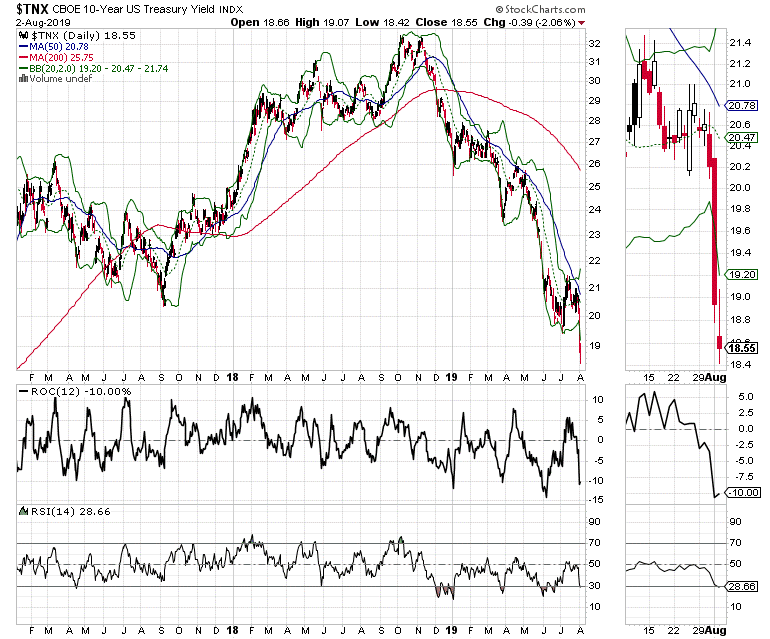
The odds are higher for a continuation of the price decline in stocks than they have been at any time since October 2018. In fact, the stock market maybe within one or two more bad days of making what could be a significant top if it hasn’t already done so.
That said, there are no guarantees for an improvement in the housing market, although the action in Skyline Champion (SKY), a stock I recommended on June 19, 2019 suggests that the premise of low cost manufactured homes is increasingly attractive both to investors as well as the general population (see chart). Certainly, the rally in SKY is not surprising, given the fact that the company gave very positive guidance in its previous earnings report, and that it came through with a nice earnings beat in its most recent missive.
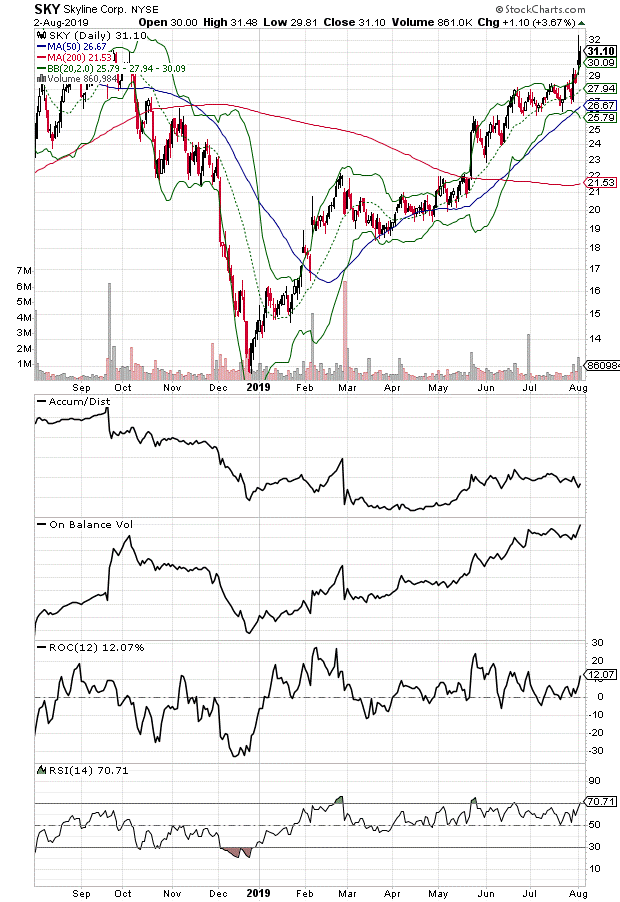
All things considered SKY beat its earnings expectations by 0.02¢ per share as revenue increased by 15.4% in Q1 2020 compared to the prior year. More important the company delivered a profit compared to a loss YOY, as sales rose by 20%. Even better, SKY’s future looks bright and the company continues to add manufacturing plants in the U.S., while improving its balance sheet by increasing its cash on hand and borrowing capacity significantly.
So even in these troubled times, owning shares in SKY as long as the uptrend remains intact make sense to investors who are willing to take some risks.
It’s MEL Decision Time
Well, the fights between the Federal Reserve and President Trump and the President and the Chinese are in full swing. Meanwhile the Market-Economy-Life (MEL) continuum has a decision to make. Normally this level of bond yields should be a positive for mortgage rates. The question is whether people will open up their wallets in response to the changing interest rate environment and the market’s response. Let’s not forget that the 401 (k) plan and the home equity line of credit are the backbone of the financial decision making process for many Americans. Thus, it is the interplay between the bond and stock market, as well as the employment situation that will fuel the next round of decision making for consumers. Furthermore, even as mobile homes are in vogue, it will be interesting to see what happens in the much larger conventional housing sector over the next few weeks.
Of course, since it may take a few weeks to get the official data stream on housing, I will be doing my Peter Lynch thing (kicking the tires) and watching the action in home sales in my daily travels to see how things develop.
Specifically, there are three houses in two distinct areas that I have been watching. One of them is not a very attractive home which has been on the market for $500,000 for several months. It is clearly overpriced, and even though it is in a very attractive neighborhood where other similar priced houses have been steadily selling, given the amount of expense likely required to restore this home, I would not expect it to sell without a significant discount from the current asking price. However, if this house sells now that mortgage rates are likely to fall, it would signal that people who have been waiting for lower rates have finally made their move.
The other two homes are in a trendy neighborhood favored by up and coming young tech professionals and are in the $800,000 price range. These two homes are exceptional, recently built homes with large lots, multiple modern amenities, and location. But interestingly, both are now featuring reduced tags, which means that the asking prices are well out of the market’s current range, a trend which is likely to increase.
Furthermore, while the home above is more likely to have been paid by its owners, both of the newer homes with the higher price tags have already been on the market for more than 45 days. This means that the sellers may be getting itchy, since they are likely to still be on the hook for $3,000 plus monthly mortgage payments while they wait.
My point is that for MEL, it’s now about what lower interest rates will do to people’s willingness to take risks on big ticket items. If any of these houses sell in the next few weeks, I suspect it will be a sign that those who have been sitting on their wallets have reached their point of action. And if that starts happening on a regular basis, it will be worth noting, especially in the context of what’s going on in the markets and the economy. On the other hand, if these houses linger on the market despite what are likely to be ridiculously low mortgage rates in the offing, I would expect that MEL is signaling that more serious problems for the economy have arrived and may be accelerating.
Market Breadth Collapses
On July 19 the New York Stock Exchange Advance Decline line (NYAD), the most accurate indicator for the stock market’s trend since November 2016 rolled over. Last week I noted the incomplete recovery in NYAD and hoped that the line would deliver a full recovery by delivering a new high on a Friday.
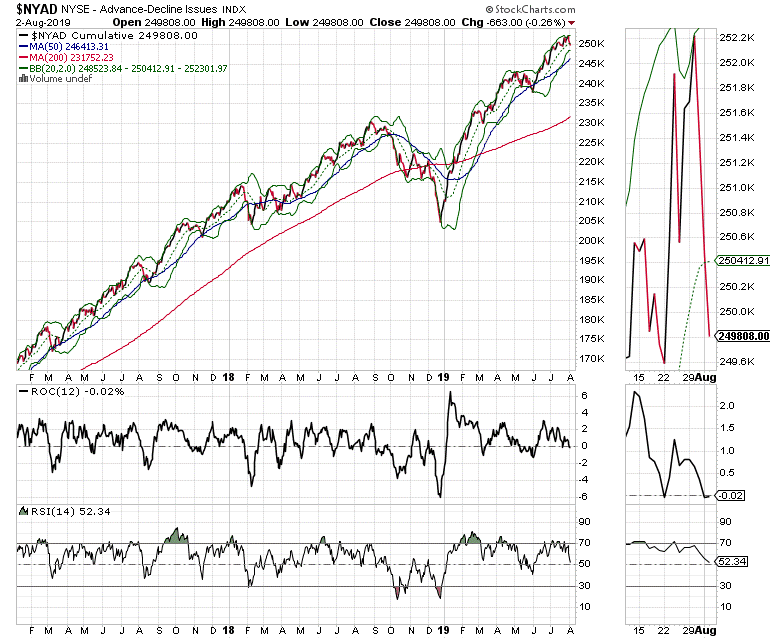
Unfortunately, thanks to the Fed’s ambivalence and the ratcheting up of the U.S.- China trade war, the NYAD collapsed, which means that until it can straighten up, the bears are back in charge. Specifically, the key is what happens if and when NYAD hits its 50-day moving average. A failure there will likely lead to a further breakdown and more pain for stock traders on the long side.
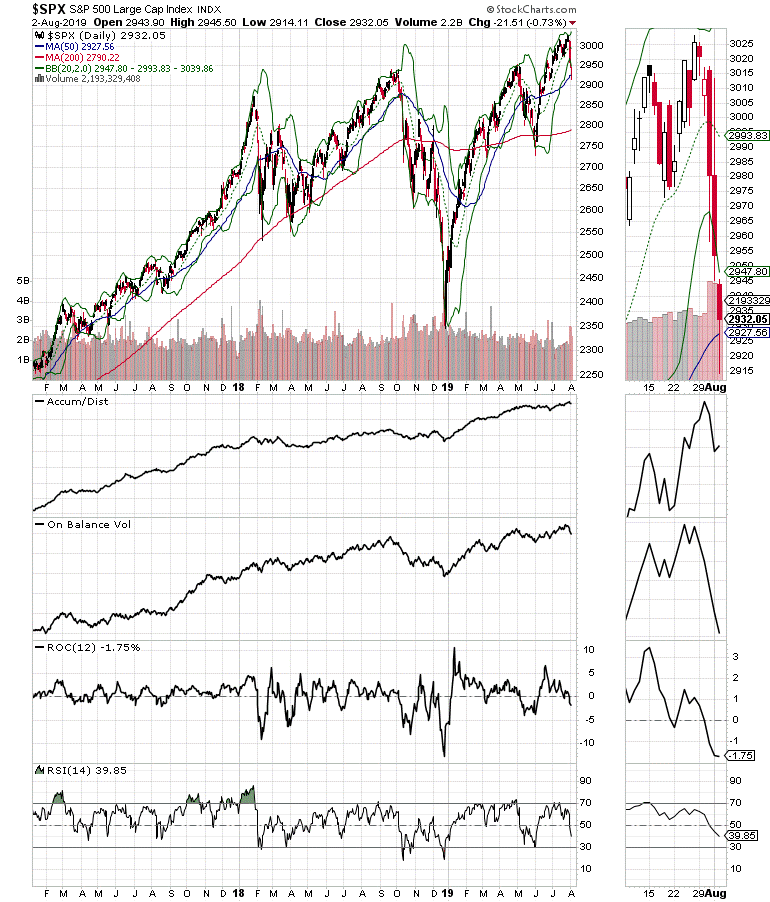
Moreover, NYAD is not alone as both the S&P 500 (SPX) and the Nasdaq 100 (NDX) indices both rolled over and are now testing key support. Of some comfort is that both indices bounced off of their 50-day moving averages on Aug. 2. But this story is still evolving. Thus, a break below this key support would likely lead to a trip down to the 200-day moving average.
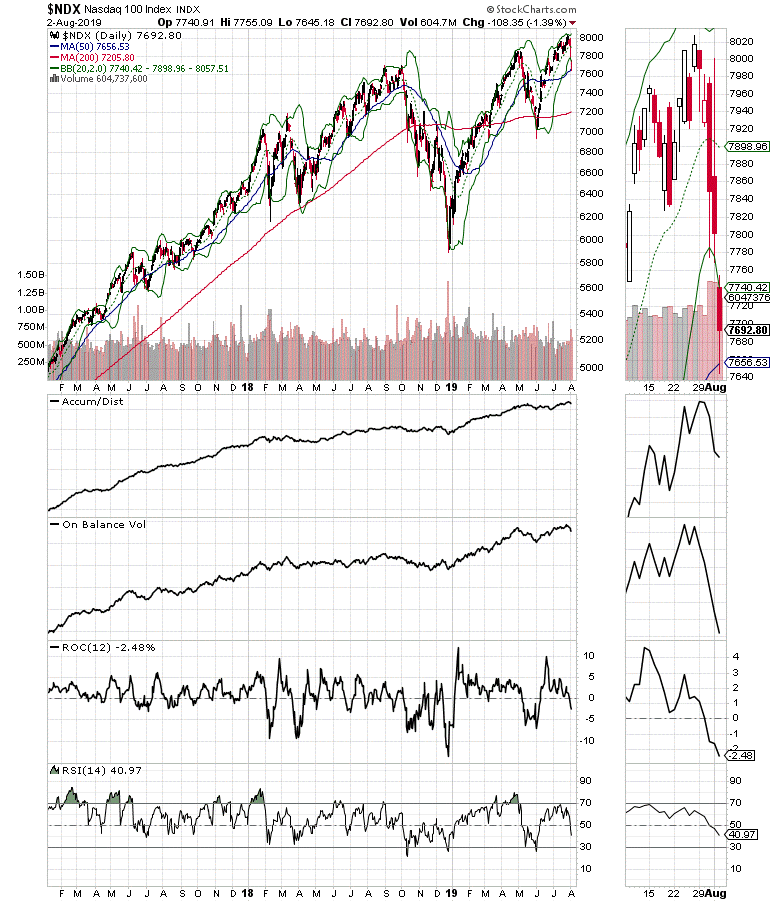
The silver lining of the current selling may be that the relative strength index (RSI) has fallen rapidly and that it is testing the 45-50 area which has proven to be good support in the past six months.
owever, a break below this area would likely mean a trip all the way to the 30 area which would likely mean aggressive selling has taken hold of the stock market.
Stay Calm & Stick with what’s working
This market looks terrible at the moment. But because it is being influenced by the news cycle, it could turn around on a dime as the algorithms switch gears if the news changes. As a result, there is little to do other than stay hedged, to use 5% sell stops, let the winners ride, and cut the losses short.
Furthermore, much depend on the effect of the bond yield collapse on people’s pocketbooks, and the potential for this decline in stocks to become oversold in the not too distant future. So if the data starts improving in the next few weeks, or Trump and the Chinese strike a deal, especially when the market reaches a seriously oversold level, as it is likely to do if things don’t change, that combination of events may be good enough to start yet another move higher in stocks.
I own SKY as of this writing.
Joe Duarte has been an active trader and widely recognized stock market analyst since 1987. He is author of Trading Options for Dummies, and The Everything Guide to Investing in your 20s & 30s at Amazon. To receive Joe’s exclusive stock, option, and ETF recommendations, in your mailbox every week visit here.





















